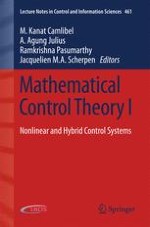This treatment of modern topics related to mathematical systems theory forms the proceedings of a workshop, Mathematical Systems Theory: From Behaviors to Nonlinear Control, held at the University of Groningen in July 2015. The workshop celebrated the work of Professors Arjan van der Schaft and Harry Trentelman, honouring their 60th Birthdays.
The first volume of this two-volume work covers a variety of topics related to nonlinear and hybrid control systems. After giving a detailed account of the state of the art in the related topic, each chapter presents new results and discusses new directions. As such, this volume provides a broad picture of the theory of nonlinear and hybrid control systems for scientists and engineers with an interest in the interdisciplinary field of systems and control theory. The reader will benefit from the expert participants’ ideas on exciting new approaches to control and system theory and their predictions of future directions for the subject that were discussed at the workshop.
